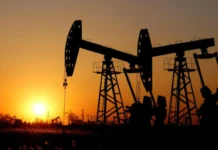The 10 Largest Oil Fields In The World – One Of Them Is In Iraq
Energy Economy News – Follow-up The question “Where is the largest offshore oil field in the world?” is widely asked in global economic and energy circles, particularly in light of recent developments in the oil industry and the drive by producing countries to increase their production capacity.
According to data from the Encyclopedia of Oil and Gas Fields, the obvious answer is that the world’s largest offshore oil field is located in Saudi Arabia. The Safaniya field has a long history of production and huge reserves that the Kingdom continues to exploit.
The increased focus on identifying the location of the world’s largest offshore oil field stems from global competition for energy resources, as Saudi Arabia seeks to strengthen its position as the world’s largest oil producer and exporter through massive development projects for the Safaniya offshore field.
The question also arises: Where is the world’s largest offshore oil field located? While a number of countries, such as China, are making new offshore discoveries, the Safaniya field retains the title of the world’s largest in terms of proven reserves and total production.
Saudi Safaniya Field
The Safaniya field in Saudi Arabia is the world’s largest offshore oil field. It is located in the Arabian Gulf, approximately 200 to 260 kilometers north of Dhahran, Saudi Arabia. It has been operated by Saudi Aramco since its official discovery in 1951.
The Safaniya field extends over an area of 50 kilometers in length and 15 kilometers in width, and contains proven reserves estimated at approximately 15 billion barrels of heavy oil, while total production extracted from it to date has reached more than 19.2 billion barrels.
Exploration work on the world’s largest offshore field began in 1939, after Aramco geophysicist Dick Kerr noticed an underwater high area. This reinforced his prediction of the presence of massive oil reservoirs, which was later confirmed when oil began flowing in large commercial quantities on August 15, 1951.
The Safaniya offshore field represents a key pillar of Aramco’s strategy to expand offshore production. It is also the fifth-largest oil field in the world in terms of total proven reserves and production, according to Saudi oil field data from the specialized energy platform.
The 10 Largest Oil Fields In The World
The Safaniya field’s importance extends beyond its status as the world’s largest offshore oil field. It also plays a key role in the global energy mix, strengthening Saudi Arabia’s position as a global energy powerhouse, especially as its expansion plans continue through 2027.
Safaniya Field Production
The Safaniya field witnessed its strong production launch in mid-April 1957, with a production capacity of 50,000 barrels per day from 18 wells. This production then increased in 1962 to 350,000 barrels per day from 25 wells.
Historical data indicates that its reserves during that period were estimated at approximately 37 billion barrels of oil, in addition to 5.36 billion cubic feet of natural gas.
Reports indicate that oil extracted from the Safaniya field accounted for approximately 22% of the total energy mix in Western Europe during that time, reflecting the field’s global importance.
Developing The World’s Largest Offshore Oil Field
Saudi Aramco seeks to boost the production capacity of the Safaniya field, the world’s largest offshore oil field, from the current 1.3 million barrels per day to approximately 2 million barrels per day in the coming years.
This comes as part of Saudi Arabia’s plan to increase total production capacity to 13 million barrels per day by 2027.
In January 2024, Aramco announced that it was close to awarding massive contracts worth $5 billion to develop the Safaniya field, including the construction of onshore and offshore infrastructure facilities, and selecting international companies to carry out the work, such as Larsen & Toubro and Hyundai Engineering & Construction.
The Saudi Safaniya field development project includes the construction of a giant gas-oil separation facility, four offshore gathering platforms, 29 wellhead platforms, 22 water injection platforms, and offshore accommodation facilities for workers. https://economy-news.net/content.php?id=54338
Erbil And Washington Agree On The Need To Resume Oil Exports From The Kurdistan Region Of Iraq.
Economy | 06:14 – 11/04/2025 Mawazine News – Baghdad The governments of Iraqi Kurdistan and the United States agreed on Friday on the necessity of resuming oil exports from the region.
A statement from his office received by Mawazine News stated that “Kurdistan Regional Government Prime Minister Masrour Barzani discussed the latest developments in the region in a phone call on Friday with US Secretary of State Marco Rubio, stressing the importance of strengthening bilateral relations.”
The two sides agreed, according to the statement, on “the importance of strengthening and consolidating the bonds of friendship and alliance between the Kurdistan Region and the United States of America.”
The statement indicated that “the Prime Minister agreed with the US Secretary of State on the necessity and importance of resuming the export of Kurdistan Region oil through the Iraq-Turkey pipeline.”
For his part, the US Secretary of State expressed “the United States’ deep appreciation for the role played by the Kurdistan Region as a safe haven for all ethnic and religious components,” praising “its essential contribution to maintaining the stability and security of the region.”
The statement added that “the two parties agreed on the importance of maintaining consultation and coordination between them, to preserve common interests.” https://www.mawazin.net/Details.aspx?jimare=260756
Oil Prices Continue To Decline Amid Fears Of Slowing Global Demand.
Economy | 01:13 – 11/04/2025 Mawazine News – Follow-up Oil prices fell today as markets anticipated a second consecutive weekly loss amid growing concerns about slowing global demand due to trade tensions between the United States and China.
Brent crude futures fell 31 cents, or 0.5 percent, to $63.02 a barrel, while U.S. West Texas Intermediate (WTI) crude futures fell 36 cents, or 0.6 percent, to $59.71. Both contracts closed Thursday down more than $2.
Brent is expected to fall 4 percent this week after falling 11 percent the previous week, while U.S. crude is expected to fall 3.8 percent following a similar decline last week. Several experts indicate that oil prices remain under pressure due to ongoing concerns about a slowing global economy, which could negatively impact demand levels. https://www.mawazin.net/Details.aspx?jimare=260748
For current and reliable Iraqi news please visit: https://www.bondladyscorner.com/






